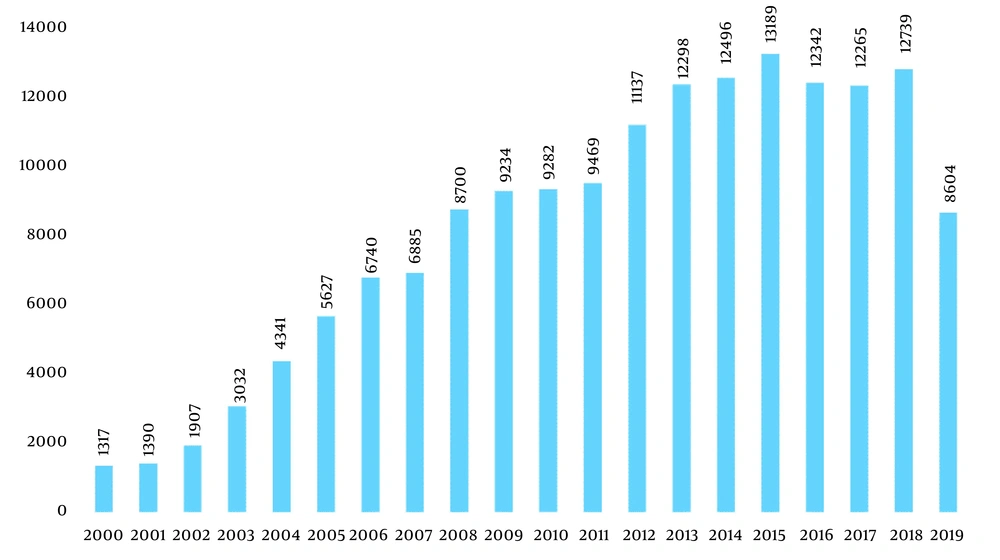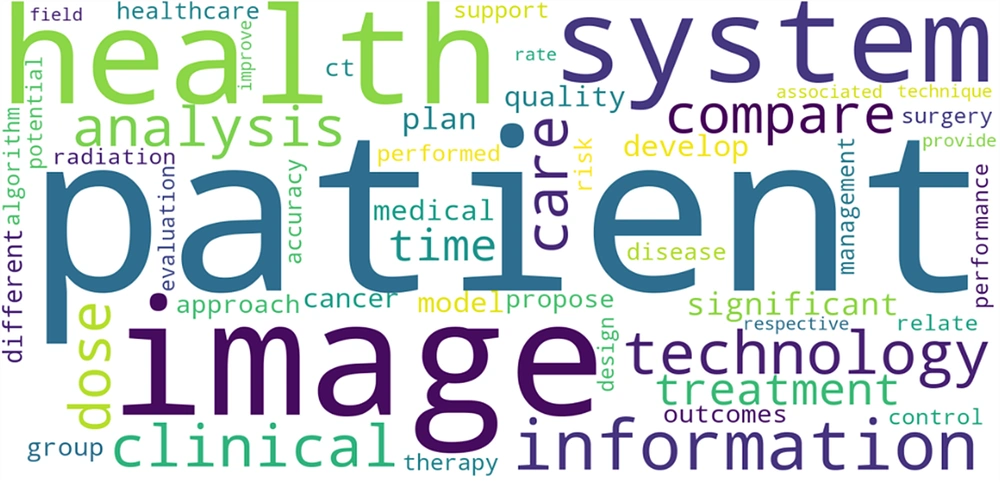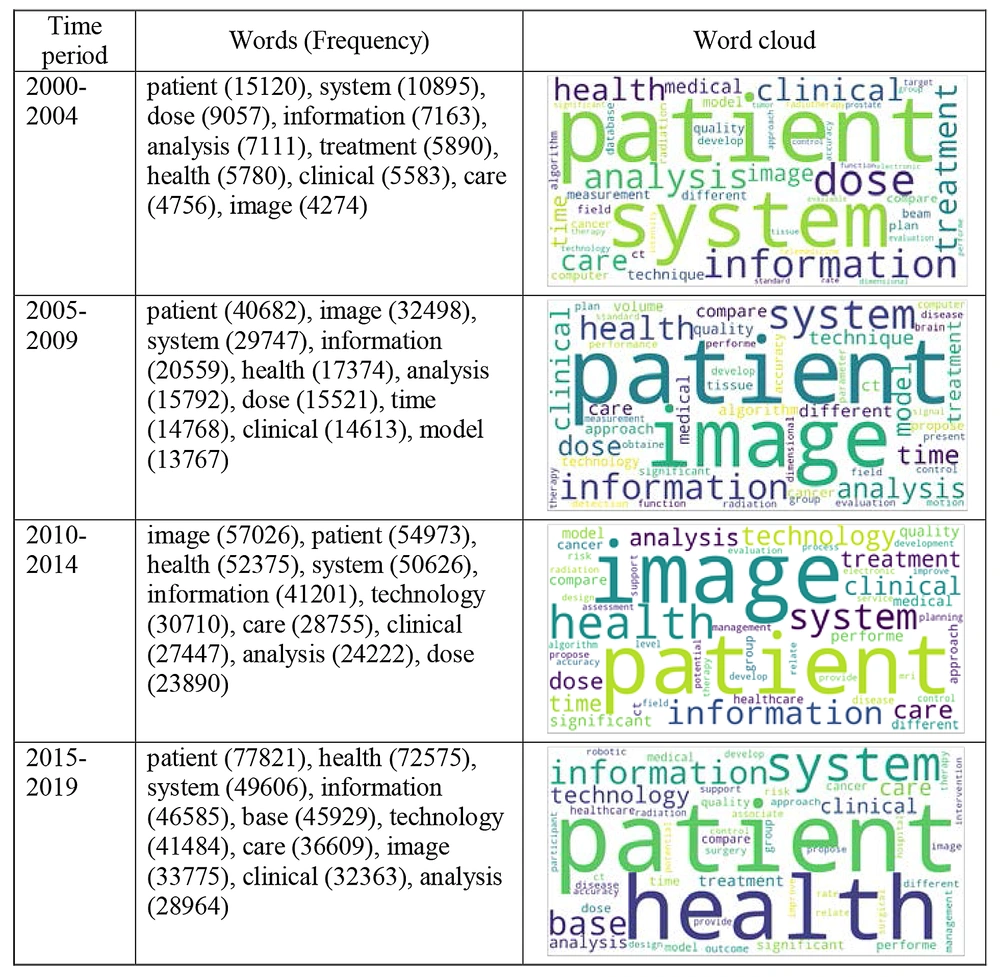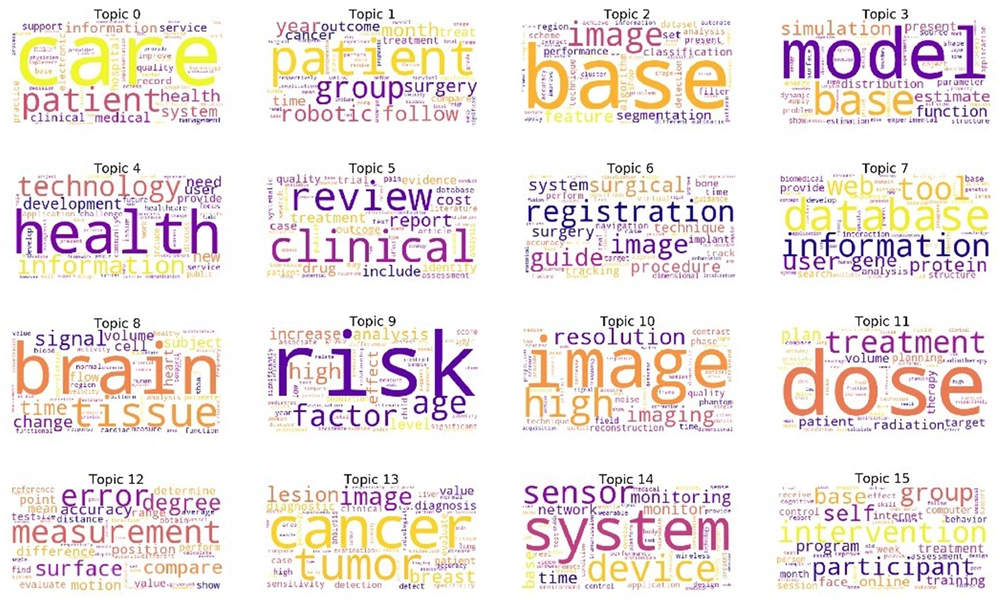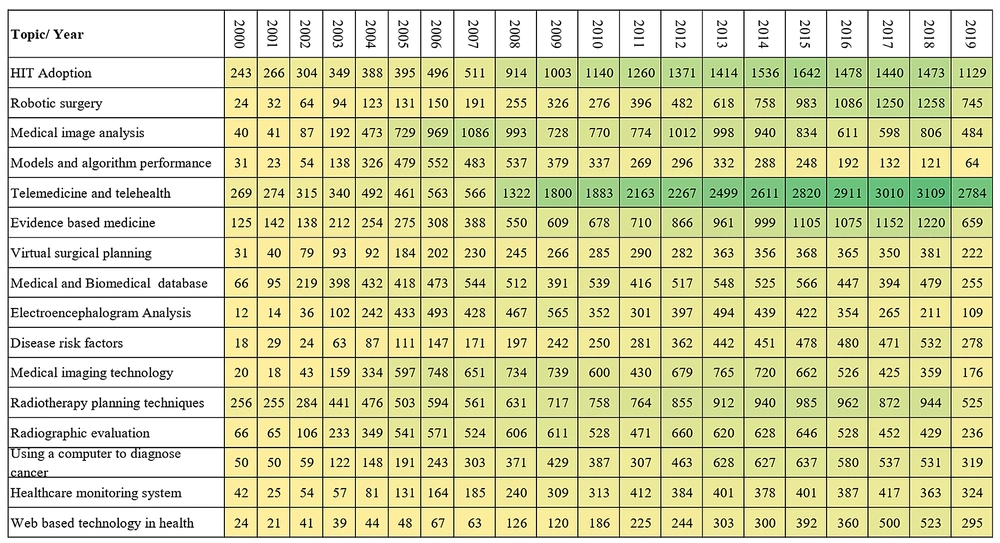1. Background
Health information technology (HIT) is one of the young and interdisciplinary scientific fields in medical sciences that has attracted researchers’ attention from different fields. This scientific field includes various types of information and communication technologies (1) including a wide range of products, technologies, and services such as telehealth technology, cloud-based services, medical devices, remote monitoring devices, and sensors (2), for patient data collection, transfer, display, and storage (1). HIT also leads to the safe and confidential delivery of health information to patients, increases the efficiency of information exchange between physicians and patients, increases the quality of care, and reduces operating costs (3-5). Analyzing published texts in this field is necessary due to the rapid growth and variety of HIT topics and medical professionals’ participation in various fields.
Identification of patterns and extraction of potential knowledge from textual data is important. Therefore, such a volume of scientific texts should be analyzed using automated tools and techniques. Generally, the extraction process of knowledge and practical and important information from various texts is called text mining (6, 7). The purpose of text mining research is to identify the topics of scientific texts, the evolution of these topics, using visualization tools for each current topic, and the relationship between them to help users identify topics (7).
Various researchers have analyzed the scientific documents and articles published in credible journals and citation databases by using text mining techniques, including topics related to insomnia and disorders (8), analysis and evolution of Mobile Health research (9), identifying published research trends in the anesthesia field (10), analysis of health information articles (11), medical library and information science (12), medical and biomedical education (13), and personality disorders (14).
In the field of HIT and medical informatics, Kim and Delen identified the medical informatics research trend to understand the current state, the progressive paths, and the existing limitations of medical informatics. For this purpose, they analyzed 26,307 article titles and abstracts of 23 selected journals in the HIT field from 2002 to 2013 using text mining techniques (15). Shokouhian et al. also analyzed 6863 articles in the field of health records between 2009 and 2019 using text mining and bibliometric techniques. According to their results, the topics published in this scientific field have shown a growing trend in recent years, and the topics of electronic health records, health care, and healthcare systems have been of great importance (16). Feng et al. analyzed 62,340 articles in the medical informatics field using text-mining techniques and topic-modeling algorithms. Based on their results, topics such as new health technologies, drug safety, algorithm optimization, and medical information standardization are new and emerging in medical informatics (17).
According to the previous research review, the analysis and evaluation of scientific publications are crucial methods for researchers, organizations, and scientific policymakers at the international level. A growing trend in scientific publications has created a large amount of research data. The solution to this challenge and managing such a massive volume of publications is topic modeling and analyzing keywords in articles using automated text mining. Text mining is a statistical method that examines publications and documents to identify their contents and topics (18, 19).
Topic modeling is one of the most potent text mining techniques for exploring textual data exploration, embedded patterns in texts, and textual document connections (20), which reveals hidden topics in a set of documents (21). Researchers believe that topic modeling is a useful tool for information extraction from textual data and performs better in information retrieval than many traditional approaches (22).
Briefly, it can be acknowledged that topic modeling is a reliable and practical tool for scientometric studies that can respond to researchers' needs to explore a huge collection of scientific texts. It also introduces a structured and automated method to identify texts' content topics, a process beyond the power of traditional methods (23). The results of topic modeling can analyze the relationship of topics with each other and the evolution of topics over time (19). It discovers important and relevant topics and terms, track them over time, and provides an opportunity for analysts to better understand connections and changes (24).
2. Objectives
At the macro level, it also has many applications and effectiveness in strategic decisions and scientific and research policy-making in the health system (22). As a result of the importance of analyzing scientific texts, this study investigated the published topics in the HIT field and their trends over time through text-mining techniques and topic-modeling algorithms.
3. Methods
3.1. Sample and Data
The study was conducted using text mining and analytical methods. The population was all HIT-related publications in English from 2000 to 2019, which were indexed in PubMed and Scopus citation databases. The Mesh Browser was used to determine the search strategy, and it was consulted with HIT experts to determine the main keywords in the search strategy design. Only the three topics listed (Medical Informatics, Telemedicine, and Health Information Management) are relevant to the HIT domain in the mesh tree hierarchy, and no other items are left out. (Table 1).
| Database | Search Strategies |
|---|---|
| PubMed | ((((("Medical Informatics/adverse effects"[Mesh] OR "Medical Informatics/classification"[Mesh] OR "Medical Informatics/economics"[Mesh] OR "Medical Informatics/education"[Mesh] OR "Medical Informatics/instrumentation"[Mesh] OR "Medical Informatics/methods"[Mesh] OR "Medical Informatics/nursing"[Mesh] OR "Medical Informatics/organization and administration"[Mesh] OR "Medical Informatics/pharmacology"[Mesh] OR "Medical Informatics/psychology"[Mesh] OR "Medical Informatics/rehabilitation"[Mesh] OR "Medical Informatics/standards"[Mesh] OR "Medical Informatics/statistics and numerical data"[Mesh] OR "Medical Informatics/supply and distribution"[Mesh] OR "Medical Informatics/therapeutic use"[Mesh] OR "Medical Informatics/therapy"[Mesh] OR "Medical Informatics/trends"[Mesh] OR "Medical Informatics/veterinary"[Mesh])) OR ("Telemedicine/classification"[Mesh] OR "Telemedicine/economics"[Mesh] OR "Telemedicine/ethics"[Mesh] OR "Telemedicine/history"[Mesh] OR "Telemedicine/instrumentation"[Mesh] OR "Telemedicine/legislation and jurisprudence"[Mesh] OR "Telemedicine/methods"[Mesh] OR "Telemedicine/organization and administration"[Mesh] OR "Telemedicine/standards"[Mesh] OR "Telemedicine/statistics and numerical data"[Mesh] OR "Telemedicine/trends"[Mesh])) OR "Health Information Management"[Mesh]) AND ("2000/01/01"[PDat] : "2020/12/31"[PDat]) AND English[lang]) Sort by: Title Filters: Publication date from 2000/01/01 to 2019/12/31; English |
| Scopus | TITLE-ABS-KEY (health AND information AND technology) AND (LIMIT-TO (LANGUAGE , "English")) AND (LIMIT-TO (PUBYEAR , 2002-2019) AND ( LIMIT-TO (SUBJAREA , "MEDI") OR LIMIT-TO (SUBJAREA , "COMP") OR LIMIT-TO ( SUBJAREA , "ENGI") OR LIMIT-TO (SUBJAREA , "HEAL") OR LIMIT-TO (SUBJAREA , "NURS") OR LIMIT-TO (SUBJAREA , "PHAR") OR LIMIT-TO (SUBJAREA , "BUSI") OR LIMIT-TO (SUBJAREA , "DECI") OR LIMIT-TO (SUBJAREA , "NEUR") OR LIMIT-TO (SUBJAREA , "MULT") OR LIMIT-TO (SUBJAREA , "DENT") OR LIMIT-TO (SUBJAREA , "VETE") OR LIMIT-TO (SUBJAREA , "Undefined")) |
The Search Strategy
A total of 208235 publications (Scopus: 67386 and Pubmed: 140849) related to HIT were extracted from the databases. Then after removing duplicates, 162,994 documents were selected; the titles and abstracts were analyzed using the text mining method taken from the designed framework by Zhang et al. (25), which includes three stages: text preprocessing, text mining operations, and interpretation of results.
3.2. Data Preprocessing
Titles and abstracts of retrieved publications data were merged in a text field to accomplish the text mining process. Then, the data was followed by preprocessing and data cleaning operations.
Preprocessing and data cleaning operations were applied to the text data to increase data quality and validity of patterns and extracted relationships, and it increases data quality, pattern validity, and extracted relationships and maintained only the required textual data (3).
In this research, the preprocessing included the following steps:
- eliminating unimportant characters, extra empty spaces, text formatting tags, and removing non-alphabetic characters such as deleting punctuation marks or numbers from the text).
- breaking text components into words (Tokenization).
- converting uppercase to lowercase letters for text unification
The stop words and other words that are not valuable for retrieving or analyzing documents, such as conjunctions and suffixes (and, the, of, for), were eliminated. As a result of evaluating the textual data, other words that were repeated and did not have a specific meaning were also added to the list of stop words.
The unification of synonyms was performed manually. Lemmatization was also used to create different forms of uniform words. Words or their primary dictionary forms were replaced with conjugated forms through lemmatization.
3.3. Topic Modeling
The next step was to perform the topic modeling algorithm and visualization with different text mining techniques, and the results of text mining operations were interpreted in the final step. In this research, topic modeling algorithms and patterns were used as machine learning techniques to discover the hidden topics in HIT global publications.
One of the topic modeling implementation methods is the Latent Dirichlet Allocation (LDA) (26), which is a very effective method for the identification of related semantic topics in scientific texts (27). Along with the LDA algorithm's strengths, it also has limitations in predicting the number of topics. Therefore, logarithmic (log) UMass Coherence was used to predict the number of topics and eliminate LDA limitations (28). Sixteen topics were selected for HIT publications using the UMass criteria. It should be noted that voluminous topics will lead to trivial and similar topics in the topic modeling algorithm (29, 30); thus, topic interpretation will be more difficult due to the dispersion of keywords in topics (31). Therefore, the number of topics should be determined logically, with thematic expert advice, and according to the extent of the topic matter (32). The LDA algorithm also determines the optimal number of topics, the frequency distribution of documents in the selected topics, and the keywords list related to each topic; however, it cannot do automatic labeling, and hence, topic labels are defined and specified non-automatically (33). Therefore, the topics resulting from the LDA algorithm are labeled and interpreted using each topic's most important words and articles.
In the present article, in the beginning, the number of topics was obtained for all data of HIT publications, and then, the signification of the number of topics and topic modeling were completed for publications related to each of the obtained topics.
Furthermore, after the words were identified, the publications related to each topic were labeled for that topic by consultation with a topical expert.
Python and Genism Library are used for the topic modeling algorithm, and Genism Library is used for open source topic modeling; it has a simple syntax, small size, and multipurpose use (34).
4. Results
The publication trend of HIT articles
Figure 1 shows the trend of global publications in the Scopus database of the HIT field over time.
The data in Figure 1 show that the trend of global HIT publications has shown an upward growth since 2000, and the highest number of articles in this field was published in 2015.
4.1. Identifying the Most Important Words Used in HIT Global Publications
Table 2 shows the ten most frequent words used in HIT publications. The results indicated that HIT publications mostly repeated the word "patients" (170,055 repetitions).
The Word cloud in Figure 2 shows the 50 most frequent words used in the HIT global publications.
| Word | Frequency |
|---|---|
| Patients | 170055 |
| Health | 148104 |
| Based | 122379 |
| Information | 115508 |
| System | 94482 |
| Care | 82092 |
| Clinical | 80006 |
| Analysis | 73382 |
| Dose | 72739 |
| Treatment | 68667 |
The Most Frequently Words Used in Health Information Technology Global Publications
In Figure 2, words with larger fonts are more important and useful. Accordingly, Figure 2 shows that the words patient, health, image, and system have been used the most.
Figure 3 shows the most frequent words used in HIT publications during 2000 - 2004, 2005 - 2009, 2010 - 2014, and 2015 - 2019.
The data in Figure 3 indicate that the terms Patients, Dose, System in the years 2000 to 2004, Patients, Information, System 2005 - 2009, Patients, Health, and Information in 2010 - 2014 and 2015 - 2019 had the highest usage and repetition.
The results of implementing the topic modeling algorithm, 16 topics, along with the most important words of each topic, are shown in Table 3.
| Topic | Name | Top Keywords | The Articles Published, No. (%) |
|---|---|---|---|
| Topic 0 | HIT Adoption | care, patient, health, system, information, medical, service, hospital, clinical, support | 18752 (11.50) |
| Topic 1 | Robotic surgery | patient, group, robotic, follow, month, year, surgery, outcome, cancer, time | 9242 (5.67) |
| Topic 2 | Medical image analysis | base, image, feature, segmentation, classification, algorithm, set, performance, detection, show | 13165 (8.08) |
| Topic 3 | Models and algorithm performance | model, base, simulation, estimate, function, present, distribution, parameter, source, estimation | 5281 (3.24) |
| Topic 4 | Telemedicine and telehealth | health, technology, information, development, new, need, user, provide, application, challenge | 32459 (19.91) |
| Topic 5 | Evidence-based medicine | clinical, review, report, cost, include, treatment, drug, identify, evidence, case | 12426 (7.62) |
| Topic 6 | Virtual surgical planning | registration, image, guide, surgical, procedure, system, surgery, technique, tracking, bone | 4724 (2.90) |
| Topic 7 | Medical and Biomedical database | database, information, tool, web, user, gene, protein, provide, analysis, search | 8234 (5.05) |
| Topic 8 | Electroencephalogram Analysis | brain, tissue, signal, time, change, subject, volume, cell, flow, heart | 6136 (3.76) |
| Topic 9 | Disease risk factors | risk, age, factor, high, analysis, increase, effect, level, population, child | 5114 (3.14) |
| Topic 10 | Medical imaging technology | image, high resolution, imaging, reconstruction, phase, quality, technique, noise, phantom | 9385 (5.76) |
| Topic 11 | Radiotherapy planning techniques | dose, treatment, plan, radiation, patient, volume, target, planning, therapy, radiotherapy | 13235 (8.12) |
| Topic 12 | Radiographic evaluation | measurement, measure, error, degree, accuracy, motion, compare, position, difference, surface | 8870 (5.44) |
| Topic 13 | Using a computer to diagnose cancer | cancer, tumor, image, lesion, breast, diagnosis, value, diagnostic, patient, detection | 6982 (4.28) |
| Topic 14 | healthcare monitoring system | the system, device, sensor, monitoring, time, base, monitor, network, application, real | 5068 (3.11) |
| Topic 15 | Web-based technology in health | intervention, group, participant, base, self, program, online, training, face, treatment | 3921 (2.415) |
Topics Result of the Health Information Technology Articles Topic Modeling Algorithm
The data in Table 3 indicate that "telemedicine and telehealth," "HIT Adoption," and "Medical image analysis" have the highest numbers of publications releases, while "web-based technology in health" has the least number.
Figure 4 also shows 50 important words of each topic in the word cloud form. Accordingly, the data in Figure 4 show what the most important and widely used words were in each topic.
4.2. The Trend of Topics in HIT Publications
The heat map chart in Figure 5 shows the trend of various topics in publications in the HIT field from 2000 to 2019. Most publications were related to "telemedicine and telehealth" in 2018, with 3109 documents; also, the growth of this topic has been from 2007 onwards. "HIT Adoption" was another topic with a high publication rate among other topics, and the highest number of articles was published in 2015 with 1642 documents; the beginning of the growth of this issue was from 2007 onwards.
"Robotic Surgery," "Evidence-Based Medicine," and "Radiotherapy planning techniques" have been some of the most popular topics in recent years, and the other publication of topics has shown the same trend, and it has been growing, Although in the last five years, the topics "Models and algorithm performance" and "Electroenceph Alogram Analysis" there has been a declining trend in publishing.
5. Discussion
The results of this study showed that "patients," "information," "health," and "system" were the most important words used in the global publications of HIT, showing the general view of these publications in this context. Other studies have shown the most important words are used based on their repetition rates and weights (35-37).
The results of topic modeling for articles in the HIT field showed a clear picture of the published topics in this field from 2000 onwards. The results of this research indicate that the publications of this scientific field have shown a growing trend since 2000, with increasing interest in publishing various topics in this scientific field.
The topic modeling results identified 16 main topics for articles in the HIT field. The "telemedicine and telehealth" topic has been popular in recent years and has the most publications in the HIT field, with a publication growth from 2016 onwards. A study by Feng et al. showed that "telemedicine" was one of the emerging topics in medical informatics research, which received great interest in this research area (17). The growth of this topic has been reported in other studies (17, 38, 39). Considering that the goal of Telemedicine and telehealth is equal access to medicine regardless of geographical location (40), it is of interest to healthcare organizations worldwide. The continued advancement of internet-based audio and video communication technologies, combined with patients' desire for easier and more efficient care, has led to the growth of Telemedicine and telehealth. Over the past two decades, telemedicine functions, including teleconsultation, intensive care services, mental health monitoring, and chronic disease management, have grown significantly as a complement or alternative to physician visits (40).
HIT Adoption was another important topic in the HIT field and has grown significantly in the last decade. Kim and Delen also considered HIT Adoption as one of the main clusters of medical informatics research, including patient information electronic systems, electronic prescriptions, data sharing, and electronic reminders for health services (15). A study by Sadoughi and Ebrahimi showed that the HIT topic areas and health information systems were the raised topics among articles in the health information management and informatics fields, and the topic of electronic health records was the most important one in this field (41).
Radiotherapy planning techniques, medical imaging technology, robotic surgery, and virtual surgical planning are other topics identified in this study. These topics have shown a slow publication trend over time. The publication of these topics indicates the interdisciplinary nature of this scientific field. For example, 3D printing technology in surgical simulator construction for training and preoperative surgery practice has been researchers' focus (42, 43). Feng also considered these as the main and emerging topics in the medical informatics field (17).
This study identified other topics like medical image analysis, using a computer to diagnose cancer, models and algorithm performance, electroencephalogram analysis, and radiographic evaluation. This subject indicates a close connection between these fields and computer engineering. In these studies, researchers extract images, collect data in more detail, and categorize those with algorithms and neural networks to provide a more accurate diagnosis of diseases. Computer images are also used to diagnose tumors, cancer, bone diseases, and special dental treatments (44). Researchers also use machine learning algorithms, image recognition, semantic analysis, and other technologies and methods to conduct in-depth investigations about information systems, decision support, medical imaging, biomedicine, and so on (45-48). Furthermore, algorithm performance optimization is increasingly used in medicine due to the increasing amount of health-related information (49-51). According to Feng (17), these are the main, interdisciplinary, and emerging topics in medical informatics. Kim and Delen also stated the application of algorithms for medical informatics research. Their study considered algorithms, neural networks, and computational technology for grouping/categorizing diseases and symptoms, the most important subset of topics in this cluster, so that anomalies are detectable by evaluating patterns (15). Evidence-based medicine is a topic in HIT that refers to systematic review articles, provides test reports and evidence-based studies for better treatment and healthcare, and is used to improve clinical outcomes (52). For medical informatics research, Kim and Delen stated knowledge representation as a topic, and this cluster includes medical text classification to report vaccination side effects, semantic disease classification, the use of medical tips in the EHR system to evaluate heart disease symptoms, a better understanding of disease diagnosis methods, management of clinical documents, report classification, medical text analysis knowledge discovery, and knowledge reuse (15). Feng has also identified this topic in medical informatics research and states that this issue is less important than other medical informatics topics (17). Similar to the evidence-based medicine subject, disease risk factors provide reports and analysis of disease trends, and this issue is declining in medical informatics (17).
The medical and biomedical database is also a topic that refers to medical and biomedical databases research such as gene and protein databases and Genome databases. The healthcare monitoring system also refers to technologies for the direct monitoring of patient's vital signs. Kim and Delen have also put these technologies in a biomedical (biomedical, medical engineering) cluster (15). Feng et al. have also addressed this topic in more detail and stated that some of these technologies in this topic, such as wearable healthcare technologies, are known as emerging. They have also stated the declining trend of some of the subset technologies of these topics, such as blood pressure monitoring systems (17). The "web-based technology in health" topic seeks to achieve goals such as using the internet or online services for care quality improvement, patients' treatment, and using online resources to conduct medical research. This topic refers to internet-based research. Kim and Delen addressed this topic in their research (15). Feng also addressed more detailed topics, such as online health information and information integration in this area, and identified them as emerging topics in the medical informatics field (17).
Dastani et al. 2022 showed that the topic of Web-based treatment is one of the growing topics in the field of medical library and information (53); therefore, this topic is one of the interdisciplinary topics in the field of library and medical information and health information technology.
However, this topic has the lowest article publication rate, suggesting that internet studies generally include various fields and are the basis of the other technologies for HIT, such as Telemedicine, the internet, and its capabilities. Generally, previous studies emphasize that the medical informatics research fields are extensive and include a variety of topics, such as management information systems, mobile healthcare, telecare, social media, data mining, and machine learning (54, 55).
5.1. Conclusions
The medical and biomedical databases topic also refers to research into gene and protein databases and Genome databases. The healthcare monitoring system also refers to technologies for directly monitoring patients' vital signs. Kim and Delen have likewise put these technologies in a biomedical (biomedical, medical engineering) cluster (15). Feng et al. have also addressed this topic in more detail and stated that some of these technologies, such as wearable healthcare technologies, are known as emerging. They have also stated the declining trend of some of the subset technologies of these topics, such as blood pressure monitoring systems (17). The "web-based technology in health" topic seeks to achieve goals such as using the internet or online services for care quality improvement, patient treatment, and online resources to conduct medical research. This topic refers to internet-based research. Kim and Delen addressed this topic in their research (15). Feng also addressed more detailed topics, such as online health information and information integration in this area, and identified them as emerging topics in the medical informatics field (17).
Dastani et al. showed that the topic of web-based treatment is one of the growing topics in the field of medical library and information (53); therefore, this topic is one of the interdisciplinary topics in the field of library and medical information and health information technology.
Yet, this topic has the lowest article publication rate, suggesting that internet studies generally include a wide range of subjects and form the foundation for other technologies for HIT, such as Telemedicine, the internet, and its applications. Generally, previous studies emphasize that the medical informatics research fields are extensive and include a variety of topics, such as management information systems, mobile healthcare, telecare, social media, data mining, and machine learning (54, 55).
